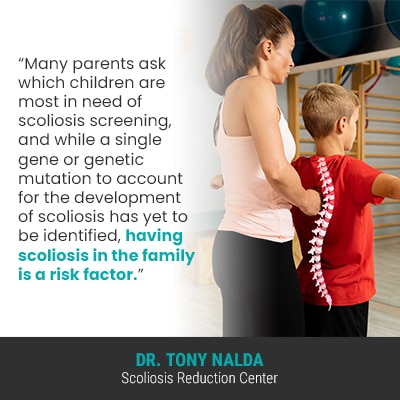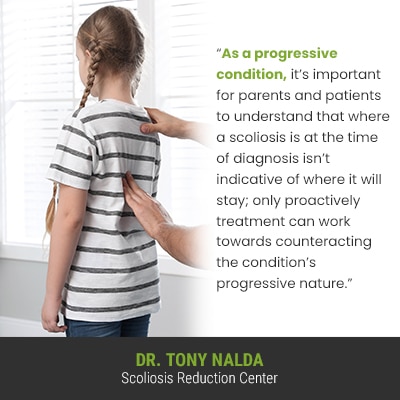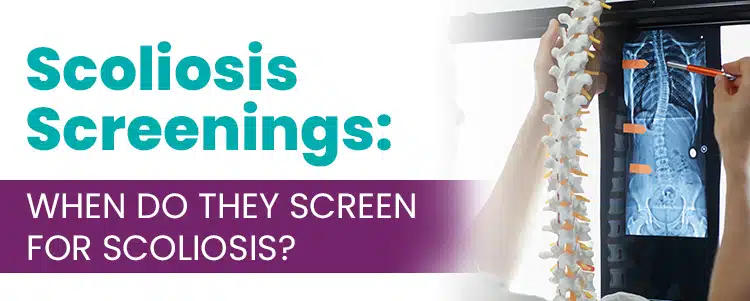Screening for scoliosis is important because it affects children, and growth and development is the condition’s tigger for progression. When scoliosis screening detects the condition’s presence early, treatment can be started early in the condition’s progressive line, when the condition is going to be its most responsive; scoliosis only gets more complex to treat as it progresses.
There are a number of benefits associated with detecting scoliosis early, and this is because as a progressive condition, scoliosis is virtually guaranteed to get worse. Scoliosis screening starts around the age of 10, prior to the first adolescent growth spurt.
Screening for scoliosis involves a physical examination and assessment performed by a medical professional, and an X-ray is needed to officially diagnose scoliosis.
What is Scoliosis Screening?
Scoliosis screening refers to the process of identifying indicators of scoliosis that warrant the need for further testing.
And for those asking, when do they screen for scoliosis, this generally starts around the age of 10, prior to the first significant adolescent growth spurt.
While scoliosis affects all ages, it’s most prevalent in children who are also at the highest risk for rapid-phase progression because growth and development is what triggers scoliosis to get worse.
As a progressive condition, scoliosis has it in its nature to worsen over time, and this means the unnatural sideways spinal curve is getting larger, and the condition’s uneven forces are also increasing, as are their effects.
The main effect of scoliosis in children is postural deviation, often in the form of uneven shoulders and hips, and these types of changes will increase and become more noticeable with increasing progression.
There was a time when scoliosis screening was mandatory and performed in schools across the United States, but that has since changed, shifting the onus of recognizing the condiiton’s early signs onto the shoulders of parents, and patients, themselves.
Scoliosis screening includes a physical examination performed by a medical professional, and this involves what’s known as the gold standard in the screening of scoliosis: the Adams’s forward bend test.
Adam’s Forward Bend Test
If a parent notices signs of scoliosis in their child, or is proactively seeking out a screening exam because another family member has scoliosis, the process would start with a physical examination conducted by a medical professional.
Here at the Scoliosis Reduction Center®, I start my physical examinations by taking the patient’s family medical history and observing their posture and gait; I can tell a lot about a patient’s spine by how they hold themselves and move.

Many parents ask which children are most in need of scoliosis screening, and while a single gene or genetic mutation to account for the development of scoliosis has yet to be identified, having scoliosis in the family is a risk factor.
Scoliosis is considered more familial than genetic, and this accounts for the higher incidence of scoliosis within families because of shared factors, other than genetics.
Families share a lot more than just their genes: socioeconomic factors, diet, lifestyle, posture, and even responses to stress.
Once I’ve identified any familial risk factors, I perform what’s known as an Adam’s forward bend test, and this involves the patient standing in front of me while bending forward at the hips at a 90-degree angle, with the arms dangling down at the sides as if reaching for the toes.
In this position, the spine is highly visible, and in some cases, particularly when the patient is thin, a scoliotic curve can be visible to the naked eye.
In addition, any related postural asymmetries such as uneven shoulders, hips, and/or the development of a rib arch are highly visible in this position.
A scoliotic curve doesn’t just bend unnaturally to the side, it also twists, and it’s the rotational element that makes scoliosis a complex 3-dimensional condition.
When an Adam’s test is combined with the use of a Scoliometer, I can determine a patient’s angle of trunk rotation (ATR).
If my physical examination has turned up condition-indicators, this warrants the need for further testing to reach an official diagnosis, and this involves a scoliosis X-ray.
Diagnosing Scoliosis
In order to reach a diagnosis of scoliosis, certain parameters have to be met.
Scoliosis involves the development of an unnatural sideways spinal curve that also rotates, meaning the spine doesn’t just bend unnaturally to the side, but also twists from front to back, back to front.
In addition, the curve has to be of a minimum size to be considered a true scoliosis: Cobb angle measurement of at least 10 degrees.
When the spine’s healthy curves are in place, its vertebrae (bones of the spine) are stacked on top of one another and aligned as they should be, but if an unnatural spinal curve develops, some of its vertebrae have become excessively tilted, shifting the spine out of alignment.
The higher a patient’s Cobb angle, the further out of alignment the spine is, and the more severe the condition:
- Mild scoliosis: Cobb angle measurement of between 10 and 25 degrees
- Moderate scoliosis: Cobb angle measurement of between 25 and 40 degrees
- Severe scoliosis: Cobb angle measurement of 40+ degrees
- Very-severe scoliosis: Cobb angle measurement of 80+ degrees

As a progressive condition, it’s important for parents and patients to understand that where a scoliosis is at the time of diagnosis isn’t indicative of where it will stay; only proactively treatment can work towards counteracting the ocndition’s progressive nature.
So if scoliosis screening has successfully led to early detection and a diagnosis, it’s time to reap the benefit by starting treatment as close to the time of diagnosis as possible.
Scoliosis Treatment
When it comes to impacting a child’s scoliosis, we’re talking about being proactive with treatment so progression can be prevented, and a curvature reduction can be achieved and held, despite the constant trigger of growth.
There are two main scoliosis treatment approaches to choose between, and each offers patients a different potential treatment outcome that affects the spine differently, which is why I want parents educated on all treatment options available.
Traditional scoliosis treatment offers a surgical response after a lot of watching and waiting, and very little action; modern conservative treatment starts actively treating conditions as close to the time of diagnosis as possible, in an effort to proactively work towards preventing progression and increasing condition effects.
Here at the Center, I apply a conservative chiropractic-centered treatment approach so conditions can be impacted on every level, and the need for invasive surgical treatment in the future can be avoided.
The benefits of early detection are only available to those whose chosen treatment approach is proactive and values working towards corrective results; a traditional reactive treatment response would recommend watching and waiting alongside a diagnosis of mild scoliosis.
Through integrating multiple forms of treatment into treatment plans, I can fully customize plans to address key patient/condition variables, and this includes condition-specific chiropractic care, physical therapy, corrective bracing, and rehabilitation.
Conclusion
The spine is important; it helps us to stand upright, practice healthy posture, move flexibly, and the spinal cord within works with the brain to form the body’s central nervous system.
In light of its many important roles, conditions that affect the spine can cause a wide range of effects felt throughout the body, but scoliosis also ranges widely in severity, and in many cases, the condition’s effects are mild and subtle.
Scoliosis screening is important because it can lead to early detection and intervention, which is associated with increased treatment efficacy.
When scoliosis is detected and treated early, there are fewer limits to what can be achieved; scoliosis is simplest to treat at its mildest, before significant progression has occurred, and before the body has had ample time to adjust to the unnatural curve’s presence.
In addition, the process of proactively working towards preventing progression is simpler than working towards reversing it once it’s occurred.
Here at the Scoliosis Reduction Center®, my patients have the full benefits associated with early detection; I respond proactively by starting treatment as close to the time of diagnosis as possible.
By integrating multiple types of treatment into a treatment plan, I can impact conditions on every level by apportioning the disciplines accordingly: based on how the spine is responding.
Scoliosis screenings are important because they can lead to early detection, which increases the chances of treatment success and improves a patient’s overall quality of life.




